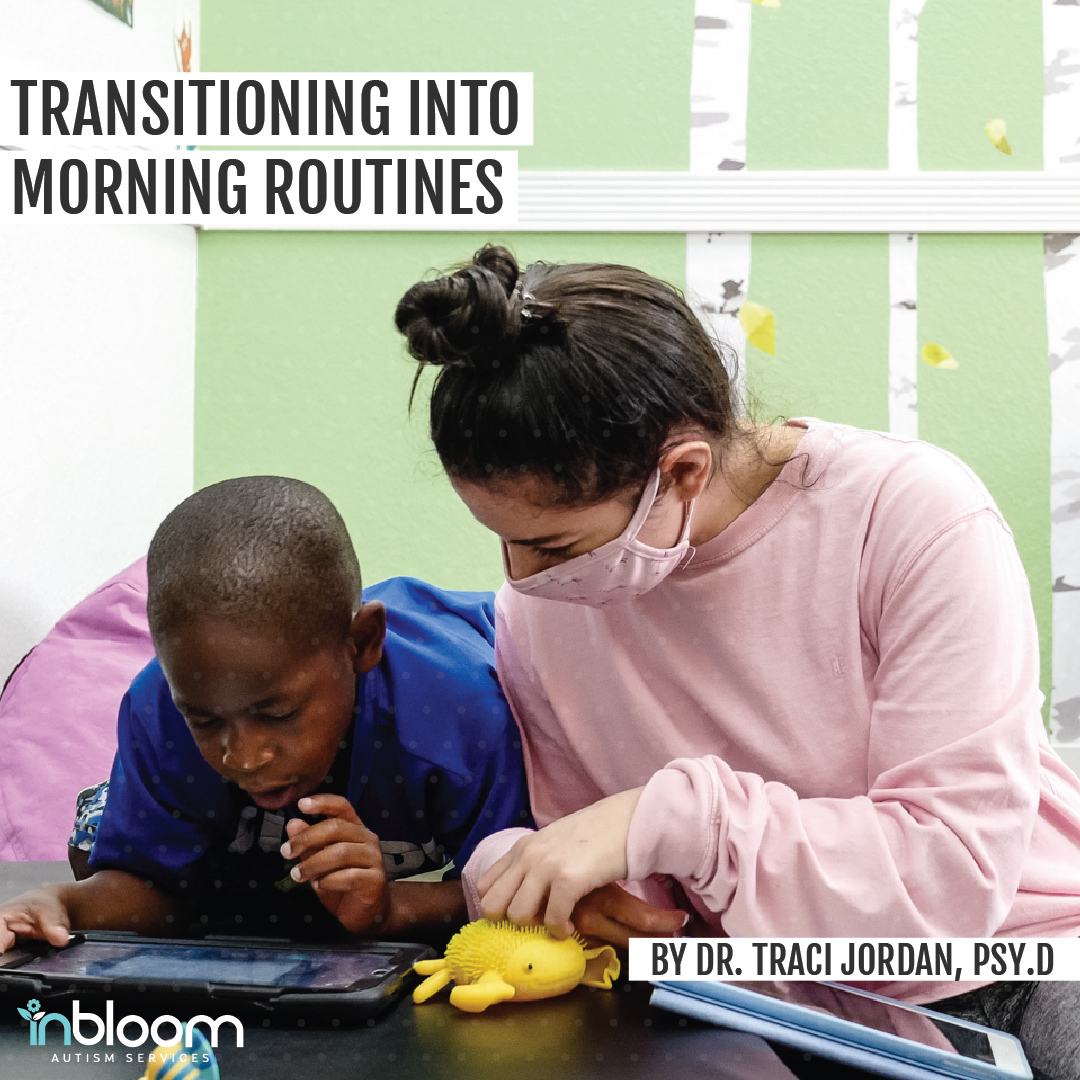TRANSITIONING INTO MORNING ROUTINES

It has been said that when we control our daily routines, we control our lives. We know that all kids, including kids on the spectrum, thrive with a structured daily routine. We also know that morning routines, for most of us, can be hard. Starting school this year with COVID-19 and associated social distancing guidelines has made mornings even harder. Traditionally, summer represents a time to relax schedules, offering a temporary reprieve from demands of hectic morning rituals (and this year, for some, the stress of online learning). However, sequestering necessitated by COVID-19 eliminated many summer activities, such as swimming lessons, playing in organized sports, and scheduling playdates with friends. Because summer 2020 has been devoid of many traditional “time markers,” returning to structured fall schedules is especially challenging this year. Now many of us are facing, with a mixture of relief and dread, the beginning of the 2020 school year and the accompanying necessity of returning to morning routines. Conjuring our inner morning lark requires planning.
Making sure everyone is getting enough sleep may be the most important thing we can do to make children on the spectrum school ready.
Start by planning a restorative sleep schedule for each family member. Making sure everyone is getting enough sleep may be the most important thing we can do to make children on the spectrum school ready. The American Academy of Pediatrics recommends 9 to 12 hours for elementary school age children (at least 12 to 13 for preschool children, including naps). However, children with ASD may have different sleep needs. They may struggle with insomnia due to repetitive behaviors and irregularities in their REM cycle (Furfaro, 2017).
For this reason, aiming for an individualized wind down and bedtime routine may be more productive for our children with ASD than attempting to coax them into an early bedtime (Chen, 2015). Remember they may be bothered by sounds, such as running water in another room, that we can barely detect. They may have adverse reactions to materials from bed sheets or pajamas. Experiment with different environmental supports (e.g., lights, sound machines, temperature, etc.) to determine what works best for your child. For example, children with ASD may sleep best with a subtle night light. They may find quiet white noise or a low, steady noise from a ceiling fan or air filter soothing. Minimize noise from other sources (e.g., siblings, TV or radio in other rooms). An occupational therapist might help you determine if your child prefers heavy or light blankets, loose or tight sleepwear. It’s the small things, like the right cuddly, that make our child’s sleep experience serene.
A morning backrub accompanied by music is a terrific wake-up strategy. Music sets a mood: consider a morning playlist of familiar favorites.
To make waking up (almost) as serene as sleep, plan to start your morning the night before. Lay out your kiddo’s clothes (I confess I’ve let mine sleep in their morning clothes when the next day activities are going to be low-keyed, but I realize this solution is not for everyone). Many children on the spectrum often thrive on preparation and knowing what to expect. Depending on your child’s language level, get their input on a personalized morning checklist or visual aid to post on the wall or the refrigerator. Adorn with pictures on a poster board for younger or less verbally fluent kids. Children with ASD are often “visual learners” and visual checklists (especially if color coded) are terrific ways of helping them process large amounts of information quickly and efficiently. Perhaps review the morning routine with them or even consider a practice run the night before. Keep it simple; start by emphasizing one part of the routine, such as teeth brushing by 7am.
Setting our child’s alarm a few minutes early may give them a chance to ease into the morning. A morning backrub accompanied by music is a terrific wake-up strategy. Music sets a mood: consider a morning playlist of familiar favorites. Catchy, upbeat songs might serve as “markers” for various parts of the morning routine, and may improve our kiddo’s time orientation.

Although tempting, avoid multitasking to save morning time because it can have the reverse effect; researchers have found that multitasking actually contributes to our levels of stress and distractibility (Winch, 2016). For children with ASD, multi-step tasks, such as teeth brushing, require focus and planning and do not respond well to multitasking. The close supervision from us during the mastery period of such tasks may include a process used in ABA therapy called “chaining:” (a) break down complex tasks, such as putting on clothes, into component parts; (b) teach by modeling or hand-over-hand each component part of the skill; (c) provide help if needed while reinforcing/rewarding, various steps in the chain.
When praising your child do not hesitate to praise the small accomplishments: positive reinforcement will keep the momentum going. Paradoxically, once a child with ASD has mastered a task, often less is more. Allowing our child to perform simple tasks themselves while continuing to give verbal praise (“I like the way you picked up your clothes”) can promote a wealth of benefits in increased autonomy. Consider an incentive for “beating the clock” and finishing the task early.
When praising your child do not hesitate to praise the small accomplishments: positive reinforcement will keep the momentum going.
As with all children, if your child is on the spectrum expect some resistance to the morning routines. Resistance may actually be a sign of our child’s need for independence! Make the resistance work for you by (a) having the child collaborate on the morning checklist; or (b) make independence the ultimate point of the routine. For example, instead of telling your child to wash their face multiple times, focus on a part of the task, such as standing on a foot stool. Reduce the chance of a power struggle by giving your child limited choices (“cereal or oatmeal?”), and praising their decision making.
Finally, even if you are a morning person and plan ahead, there will be mornings when NOTHING seems to go right. Do not be discouraged by setbacks or a tough morning. The world won’t stop if part of our routine gets left out on any given day, learning to deal with unexpected setbacks is part of the learning process. Remember, tomorrow is another day, bringing fresh learning opportunities for our children.
ABOUT THE AUTHOR

DR. TRACI JORDAN, Psy.D., L.S.S.P.
Dr. Traci Jordan, Psy.D., L.S.S.P. holds a dual license in clinical and school psychology, and has assessment experience with a wide range of developmental, cognitive, psychological problems and challenges. She has a lifelong passion for child development and family systems, completing pre and postdoctoral training in child clinical and developmental pediatrics before opening a private practice focused on child assessment and treatment. She draws on her 30 years of experience in assessment and research methods to develop and teach a core graduate level class in psychodiagnostics through the Department of Educational Counseling of Texas A&M Corpus Christi. A mother and tireless advocate for children and diversity in my personal life; I am proud of serving as a foster parent for 10 years and as a board member for Nueces County Court Appointed Special Advocates (CASA). Yoga, family, friends, and pets keep her centered.
References
Chen, Infei (2015). “Wide Awake: Why Children with Autism Struggle with Sleep.” Spectrum
News. Simon Foundation.
Furfar, H. (2017). “Sleep Problems in Autism, Explained.” Spectrum News. Simon Foundation
Winch, G. (2016). “10 Real Risks of Multitasking, to Mind and Body.” Psychology Today. The
American Psychological Association.
Also see: Healthychildren.org. (2020). American Academy of Pediatrics.



